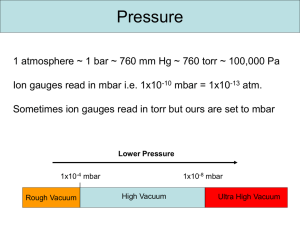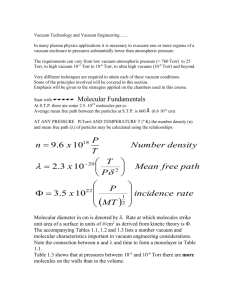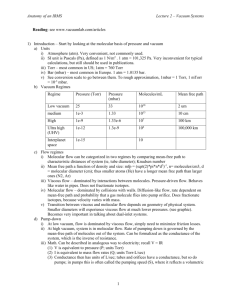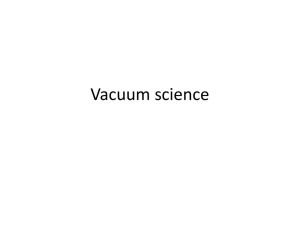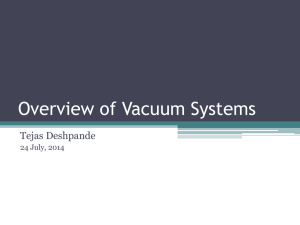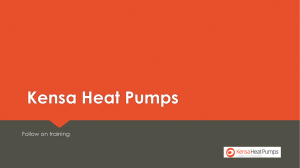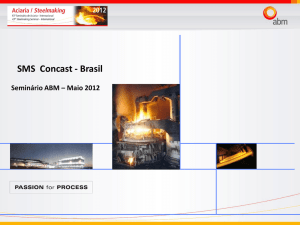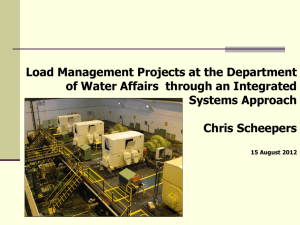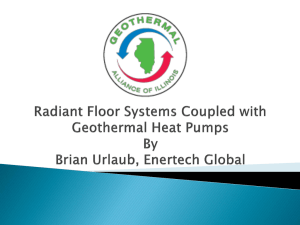Vacuum Pumps
advertisement
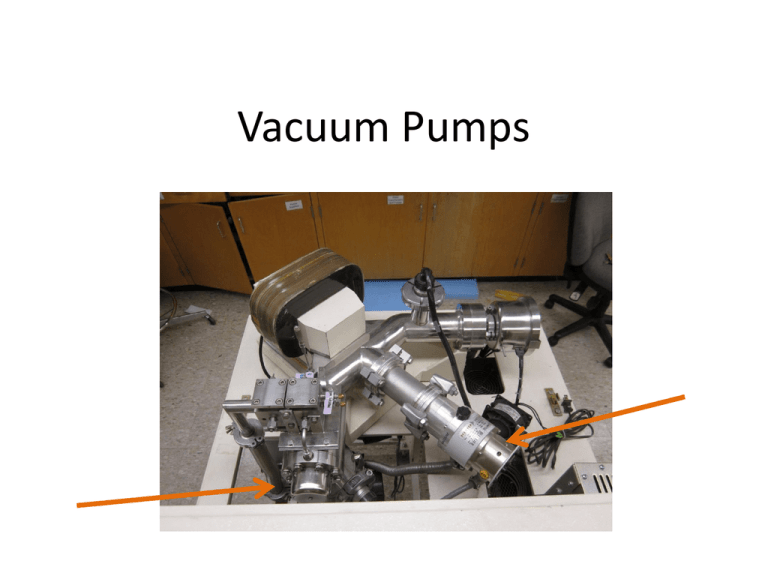
Vacuum Pumps Basics • vac·u·um – noun 1. a space entirely devoid of matter. – 2. an enclosed space from which matter, especially air, has been partially removed so that the matter or gas remaining in the space exerts less pressure than the atmosphere ( opposed to plenum). (dictionary.com) • Exhaust pressure= atm generally • Base pressure = pressure pump gets down to • Compression ratio = exhaust/base= big number • Boyles Law P1V1=P2V2 History of vacuum pumps • Suction pumps go way back (Romans, Byzantine empire, etc) • Major improvements on the idea of vacuum made by Galileo, Evangeilist Torricelli, and Blaise Pascal • Otto von Guericke made first pump and famous for Magdeburg hemispheres experiment Types of Vacuum pumps • Positive displacement pumps – Expand a cavity, seal, exhaust, repeat • Momentum transfer pumps (molecular pumps) – High speed liquids or blades to knock gasses around • Entrapment – Create solids or adsorbed gases (cryopumps) Roughing pumps • Pumps from atm pressure down to rough vacuum (0.1 Pa, 1X10-3 torr) • Necessary because turbo pumps have trouble starting from atmospheric pressure • Usually Rotary Vane pumps • Can have oil or not Rotary vane pumps Oil Sealed Rotary Pumps Understanding Gas Ballast www2.avs.org/chapters/nccavs/pdf/Gas_Ballast_OilSealedPumps.pdf Rotary vane pumps Condensation of vapor in the gas mixture is a problem with these pumps. Solution Ballasting Works by increasing the gas/vapor ratio (air is mostly gas) As you might imagine this interferes with the final vacuum Types • One stage or two stage • Belt Drive or direct drive Slower 400-600 RPM Bigger, Cheaper Faster 1500 to 1725 RPM Smaller, lighter Turbo (molecular) pumps • Gas molecules interact with spinning blades and are preferentially forced downward • High vacuum (10-6 Pa) requires rotation of 20,000 to 90,000 revolutions per minute • Generally work between 10-3 and 10-7 Torr • Ineffective before gas is in “molecular flow” Turbo (molecular) pumps • Options: – Bearings: Ceramic (oil lubricated) Magnetic (supported w/out physical contact), also hybrid – Rotor options (Blade configuration) – Cooling (air or water) Pump Care Rough pumps shouldn’t need a lot of maintenance If they do repair kits are available: Minor kit includes all necessary seals (shaft seals, valves, o-rings, etc) Major kit includes Minor Kit components plus vanes, springs, plugs, etc. Seem to be available for most major brands and types Turbopumps should need even less maintenance, bearings can wear out but must be replaced by manufacturer for balancing. http://www.sisweb.com/vacuum/sis/iseries-maintkit.htm Pump specs Displacement Spec sheet for an Edwards A65209903 RV rotary vane pump $3171 50Hz 60Hz Speed (Pneurop 6602) 3.7 m3h-1 / 2.2 ft3min-1 4.5 m3h-1 / 2.6 ft3min-1 50Hz 60Hz Ultimate pressure (high vac mode) 3.3 m3h-1 / 2 ft3min-1 3.9 m3h-1 / 2.3 ft3min-1 2.0 x 10-3 mbar / 1.5 x 10-3 Torr Ultimate pressure GB I (high vac mode) 3.0 x 10-2 mbar / 2.3 x 10-2 Torr Ultimate pressure GB II (High throughput mode) 1.2 x 10-1 mbar / 9.1 x 10-2 Torr Max inlet pressure for water vapour 80 mbar / 60 Torr Max water vapour pumping rate – GB I 60 g/h Max water vapour pumping rate – GB II 220 g/h Max allowed outlet pressure 1 bar gauge / 14 psig Max allowed inlet and gas ballast pressure 0.5 bar gauge / 7 psig Motor power 50/60Hz Nominal rotation speed 50/60Hz 450 / 550W 1500 / 1800rpm Weight (without oil) Oil capacity min/max Recommended oil Inlet flange Exhaust flange Noise level Operating temperature range 25 kg / 55 lb 0.42/0.7 litres Ultragrade 19 NW25 NW25 48 dBA @ 50 Hz 12 – 40 °C Subset of specs for Edwards EXT 556H turbomolecular pump Pumping Speed Compression ratio Ultimate Pressure (mbar) Max continuous inlet pressure (light gas pumping)† Pump rotational speed N2 ISO63/63CF (DN40NW)(ISO100) He ISO63/63CF (DN40NW)(ISO100) H2 ISO63/63CF (DN40NW)(ISO100) N2 He H2 With RV backing pump ISO/CF With diaphragm backing pump ISO/CF Outlet flange Recommended backing pump* Vent port Purge port Water cooling (water at 15 °C, ambient temp at 40 °C) Forced air cooled, 35 °C ambient Nominal rotational speed Standby rotational speed Programmable power limit settings Start time to 90% speed Analogue outputs Cooling method? Ambient air temperature for forced air cooling Min cooling water flow rate (water 15 °C) Water temp range Max inlet flange temp 61 ls-1 (42 ls-1) (66 ls-1) 57 ls-1 (49 ls-1) (59 ls-1) 53 ls-1 (48 ls-1) (54 ls-1) >1 × 1011 1 x 106 5 x 104 <5 x 10-9 / 5 x 10-10 <5 x 10-8 / 5 x 10-9 DN16NW RV5/XDS5 1/8 inch BSP 1/8 inch BSP 2 × 10-2 mbar 1 × 10-2 mbar 90000 rpm Variable from 49500 to 90000 rpm (63000 rpm default) Variable from 50-120W (80W default) 110 s ‡ Rotational speed; Power consumption; Pump temp; Controller temp Forced air / water 5 - 35 °C 15 l h-1 10 - 20 °C 100 °C Turbo pumps: opposite Pump Speed Rotary Vane: Pump speed lower at low vacuum Pressure Useful fitting terminology • Flanges – Standard quick Release (QF, KF, NW, or DN) • Named based on internal diameter DN16KF is 16mm (16-50mm) – Large Quick releases (LF, LFB, MF or ISO) • Clamps or bolts (63-500mm) – Conflat (CF) used in ultra high vacuum settings, usually metal to metal seals • Sizing odd: Europe inner diamter in mm, NA outer diameter in inches Sizes we will likely find. www.vacuumresearchcorp.com/pdfs/valves/nwflanges06.pdf Pumps on the Delta S • Pumping system for Analyzer – Turbo molecular pump TPH 050 – Vacuum pump E2 M1, 52 • Differential Pumping system – Turbo molecular pump TPH 050 – Turbo molecular pump TPH 240 – Vorvakuumpumpe E2 M5, 50160 Hz Turbo molecular pump TPH 050 Turbo molecular pump TPH 240 Units of pressure for your notes Pascal (Pa) Bar (bar) 1 Pa ≡ 1 N/m2 10−5 1 bar 105 1 at Technical atmosphere (at) Pound-force per square inch (psi) Atmosphere (atm) Torr (Torr) 1.0197×10−5 9.8692×10−6 7.5006×10−3 145.04×10−6 ≡ 106 dyn/cm2 1.0197 0.98692 750.06 14.5037744 0.980665 ×105 0.980665 ≡ 1 kgf/cm2 0.96784 735.56 14.223 1 atm 1.01325 ×105 1.01325 1.0332 ≡ 1 atm 760 14.696 1 Torr 133.322 1.3332×10−3 1.3595×10−3 1.3158×10−3 ≡ 1 Torr; ≈ 1 mmHg 19.337×10−3 1 psi 6.895×103 68.948×10−3 70.307×10−3 68.046×10−3 51.715 ≡ 1 lbf/in2


